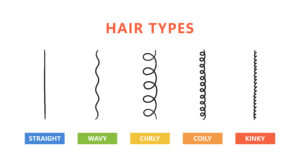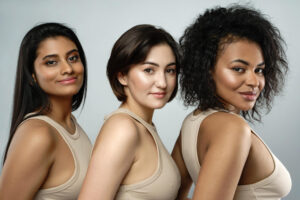CONTENTS

Short, Medium, or Long? Follow the Hair Length Chart Guide
As you peruse different products and styles for your hair, you may find yourself feeling overwhelmed. Trying to figure out the right length of hair for you can seem daunting at first.
Fortunately, there is a great way to quickly determine what length of hair will best suit your face shape, lifestyle, or desired style: the hair length chart. This helpful tool will provide insight into which lengths are best for you.
From mid-length lobs to long, flowing tresses and pixie cuts, the hair length chart offers suggestions tailored specifically to your unique look. Let’s learn more about the hair length chart here!
Hair Length Chart: Easy Measurement, Styles & Care Guide
This guide includes complete information about hair length and type, how to measure it, how to choose the right hair length, and the care tips to take care of your hair. Read on!
Length of Hair and Hair Type

There are several types of hair lengths that people can have, ranging from short to long. Here’s the explanation.
- Short length: This hair type is usually no more than two inches long.
- Medium length: Medium-length hair falls around chin level or just shoulder length hair and can be styled in various ways.
- Long length: Hair falling at or past the shoulders, such as armpit length hair, is considered long, and this style requires regular maintenance since it can dry quickly if not kept hydrated.
- Extra-long length: Any hair that reaches further than mid-back is considered extra-long.
Also, there are many different types of hair, including:
- Straight hair: This hair is often silky and shiny but can also look flat when it’s not properly styled or moisturized.
- Wavy hair: Wavy hair is known for its gentle waves and volume. It can also have frizziness when not cared for properly.
- Curly hair: Curly hair types can range from tight spirals to lose ringlets, depending on the individual’s genetics.
- Kinky hair: This type of hair is tightly coiled and prone to dryness due to a lack of sebum production on the scalp.
How to Measure Hair Length?

Measuring hair length can be done in several ways, but there are two main methods used:
Measuring tape
Using a measuring tape is the most accurate way to measure hair length. Start at the base of your scalp, where your hair starts its hair growth, and then wrap the tape around your head until you reach where your ends lay.
The result will give you an exact measurement of your hair’s length.
Hair sticks
This method involves taking two hair sticks or chopsticks and holding them against the sides of your head, with one stick towards the roots and the other towards the ends. Measure how much space is between them for an approximate estimation of your hair’s length.
Remember that these methods will only work for straight styles; if you have wavy or curly hair, it may be challenging to get an accurate measurement either way.
What’s the Right Hair Length for You?
Your Preferred Length

Choosing hair length is all about what makes you feel good. Your hair is an expression of yourself, and if that short cut has been on your mind, so why not give it a shot? You never know how liberating and freeing it might feel to let go of your long locks!
The Health of Your Locks

Hair health should be the top priority to achieve both length and thickness — both of which can add to an overall healthier look. Pay close attention to any early signs of balding, and always put a premium on looking after your hair’s needs.
Your Face Shape

When it comes to hair, how you style it can make an immense difference in how your face shape and features are highlighted — or, just as importantly, balanced out. huge
Middle-length cuts with some body and volume can do wonders for long faces, while shorter cuts often help to add volume and balance on top of rounder ones.
Of course, there’s no ‘ideal’ face shape that you need to stick to. Instead, consider what features you’d like to draw out and focus on those with your haircut!
Care Tips For Different Hair Lengths

Treating your hair properly is essential for achieving and maintaining length and keeping it healthy. Depending on the size of your hair, here are several tips to help you get started:
- Short Hair: Shorter styles can do regular trims and moisturizing products to prevent breakage. Ensure you avoid heat styling too frequently, too, such as using a hair dryer — better to keep things natural!
- Mid-Length Hair: For mid-lengths, look out for split ends, and be sure to use shampoo and conditioner that are made for your particular hair type.
- Long Hair: For long locks, frequent brushing with a wide tooth comb helps keep tangles at bay and reduces flyaways. A deep conditioning mask is also recommended once or twice weekly to maintain moisture levels in those longer strands.
Frequently Asked Questions
What is the Hair Length Chart?
The hair length chart is a helpful guide to understanding the lengths of different haircuts. In fact, different hair lengths come with different terms — from the three-digit standard lengths to more specific professional length names.
A hair length chart can help you visualize and choose the exact hair length for your style, saving you time and hassle.
Why is It Important to Know the Hair Level and Its Chart?
Understanding hair length and choosing the right style for your hair can be tricky. That’s why knowing the different lengths available via the hair length guide chart is essential.
A hair length chart is an excellent tool for finding the perfect style for you, as it clearly shows the exact measurements of each length in inches so you can find the look you want without any confusion. It’s also helpful in finding the appropriate products for your particular hairstyle.
Conclusion
All in all, the hair length charts are a great way to visualize an individual’s current and potential hair length. It’s important to remember that your hair should be a reflection of yourself.
Whether you decide to keep it short or long, the most important thing is that you are happy with the result. You can always experiment with different lengths and textures to find something that expresses your personality best. Don’t just stick with fashion trends if they don’t feel right for you.
Of course, it can be helpful to understand the various hair lengths to know what styles you may choose from when considering your next cut. Hopefully, this hair length chart has provided useful information in helping you find a cut that looks and feels fantastic!


